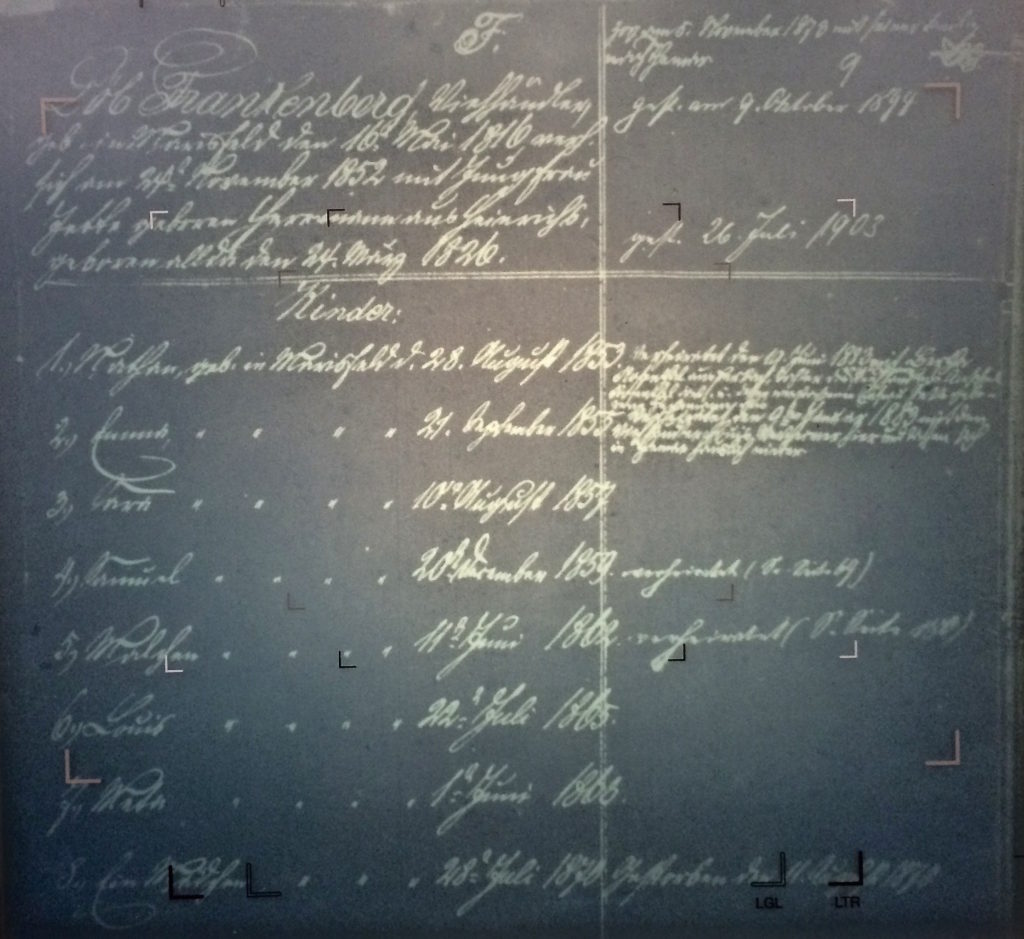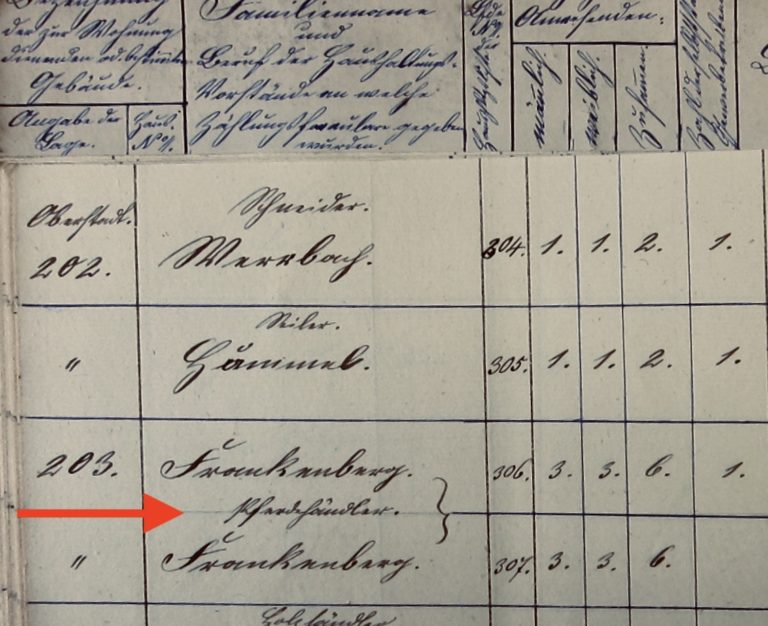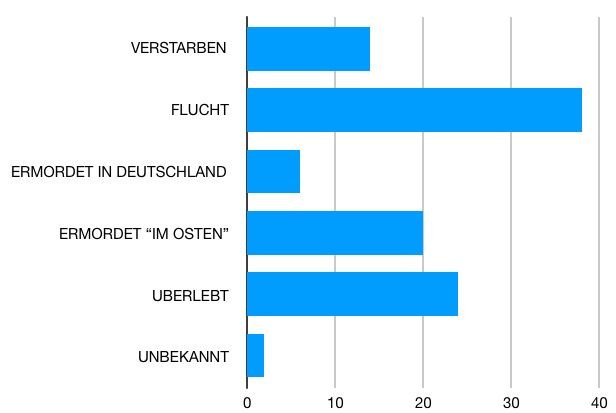See also:
The Frankenberg family
The family of Hilda (née Frankenberg) and Louis Sander
Descendants list: Löb and Jette (née Hermann) Frankenberg
Descendants list: Nathan and Regine (née Neuberger) Frankenberg
Finding the traces — one google at a time
The family of Löb and Jette (née Hermann) Frankenberg was one of the core families of the Jewish community of Themar; that is, they participated in the establishment of the Jewish community and they were there until the very last days in 1942 when the community was extinguished.

As with all the Jewish families in Themar, the Frankenberg family came from elsewhere. Löb was son of Nathan (Jonas) and Regine (née Neuberger) Frankenberg who had settled in Marisfeld in the early 1800s.
The family came to Themar sometime after September 1870, after the birth (and death) of the last child in Marisfeld, and 1875, when two branches of the family were included in the Resident/Einwohner Census. Jette did not have any more children so it was a completed family of two parents and seven (7) children, ages 4 to 17, who came to Themar.
*****

The 1875 Resident Census of Themar tells us that the Frankenbergs initially lived at Oberstadtstrasse 203, the front of which is seen in the photo.L
At the left edge of the photo is the large entrance to allow livestock to enter and exit. The Frankenbergs dominated the livestock market of Themar. Löb was identified as a cattle dealer in the Family Register above, but the Einwohner Liste indicates that he and his sons also traded horses.
Löb was at least 60 years old when he moved to Themar; his eldest son, Jonas was close to 20 years and probably already fully involved in the trade. Samuel, b. 1859 joined the family business as soon as he was old enough in the early/mid 1870s. in 1886, Samuel married Karoline Schloss of Gleicherwiesen; their first child was born (and died) in June 1887; a year later, in August 1888, a second son, Nathan, was born. “Am 23. Juli 1890 verließen Samuel und Karoline Frankenberg Themar gemeinsam mit ihrem Sohn Nathan und zogen nach Schleusingen. Hier betrieben sie in der Langen Gasse/Bertholdstraße 3 einen Viehhandel und einen kleinen Laden mit Schnittwaren.”1 Kerstin Möhring, http://www.juden-in-schleusingen.de/fam_frankenberg.html
With Samuel’s departure,37-year-old Jonas continued the trade with his youngest brother, 25-year-old Louis . They were known as the “Gebrüder Frankenberg.” Jonas was married — his wife was Bertha Rosenthal of Berkach — and they had two daughters, Ida, b. 1884 and Martha, b. 1887. Louis was not yet married; this would happen in the early 1890s when he married Klara Bauer of Königsheim.
Löb’s and Jette’s daughters followed different paths. Emma, the eldest daughter, married Louis Wertheimer, son of Mendel Emanuel Jacob and Sarah (née Gutmann) Wertheimer of Marisfeld. They had three children, two sons and one daughter. Amalie, the second daughter, married Jonas Mühlfelder of Bauerbach. They had three sons, all born in Themar. In x, the family moved to Meiningen and from there to Suhl. The story of this family has been told by Ludwig Mühlfelder in
We know very little about Sara, b. 1857. Meta, both the youngest daughter and youngest child of Löb and Jette, became one of Themar’s most respected merchants. In 1913, she married Nathan Krakauer. Löb and Jette lived in Themar for the rest of their lives: Löb died in October 1894, age 78; Jette in 1902, age 76.
*****.
In January 1933, when the Nazi Regime began, fifty (50) members of the family of Löb and Jette Frankenberg — as identified in the Nachkommenliste — were alive and living in Germany — in Themar, Schleusingen, and Suhl in Thüringen, and in other cities such as Coburg, Hannover, Essen, Dinslaken. By mid-October 1941, when the deportations of German Jews to ghettos in occupied ares in “the East” began, nineteen (19) members of the Löb/Jette Frankenberg family were still in Germany.
Since 1933, six (6) had died, we assume of ‘natural causes’. Three (3) were Löb’s and Jette’s children — Louis, the youngest, who died in Themar in July 1934; Samuel, who died in August 1936 in Schleusingen, and Sara, who died in April 1941, in Themar. Hertha Frankenberg, daughter of Louis and Klara (née Bauer), died in January 1934; Jonas Mühlfelder, widower of Amalie (née Frankenberg), died in Suhl in 1937; and Hilda Sander, née Frankenberg, died on 2 March 1938 in a Würzburg hospital.
Eighteen (18) had been able to find safe refuge. For the first time in the history of this family, emigration had become the key strategy, not just for socio-economic prosperity, but for survival. Some, including the children of Amalie (née Frankenberg) and Jonas Mühlfelder (both of whom were dead) immigrated into the United States as well as Palestine. Hedwig Frankenberg was able to acquire entry visas into the United States for herself and her two children, Ilse and Heinz, and they left on 8 August 1938. Nathan and Else (née Frankenberg) Wertheimer, and their young daughter, Edith, secured entry visas into Argentina and reached Buenos Aires.
Two members had been murdered: the first was Nathan Frankenberg, son of Samuel and Karolina Franenkberg, According to Kerstin Möhring, “during a city walk with his wife, Nathan was arrested in September 1937 under the pretext of ‘racial disgrace’ and sent to the Schleusinger prison. After a few days, on 26 September 1937, his wife received the news of her husband’s suicide. The family could not believe this, because Mrs. Frankenberg visited her husband every day in prison and brought him his food. They both hoped to be released soon.” Subsequent research has provided evidence to support Dr. Möhring’s argument that Nathan Frankenberg was murdered.
Norbert Sander, an epileptic, was murdered on 7 February 1941 in the Euthanasia program at the Hadamar Killing Centre. Norbert’s mother had died in early 1938; his father had been arrested in the Juni Aktion of 1938 and imprisoned in Buchenwald. Seventeen years old, Norbert had been arrested in the Reichspogromnacht of 9/10 November 1938 and held there until at least 2 December 1938.. The emigration of Marion, his sister, in early 1939, and of Louis, his father, later in 1939 left Norbert in Themar in the care of his 85-year-old grandmother, Bertha Frankenberg, née Rosenthal.
*****
The Fall 1941 decisions of the Nazi Regime to prohibit ‘voluntary’ emigration and force emigration to “the East” trapped nineteen (19) Frankenbergs in Germany. One, Bertha Frankenberg, née Rosenthal, escaped deportation through death. After the deportation of her grandson, Norbert Sander, to Hadamar, Bertha moved to Essen to be with her daughter Martha Katz, née Frankenberg, and her family. On 4 May 1942, Bertha died in Essen.
Thirteen members were deported to the Ghettos and killing centres.
- 27 November 1941: Lucie (née Frankenberg) and her husband, Leopold Heinemann, were deported from Berlin to Riga along with 1053 other men, women, and children. After a 3-day journey, they arrived and were taken to the wood of Rumbala where they were massacred.
- 15 December 1941: Ida Katz (née Frankenberg) and her husband Leopold Katz, were deported from Hannover to the Riga Ghetto. No dates of death are given in formal documents.
- 18 December 1941: Paula Frankenberg was arrested in Breitenau and held in jail there until when she was transferred to KZ Ravensbrück, the camp for women located north of Berlin. When she was transported from Ravensbrück to Auschwitz is unknown. On 9 October 1942, she was murdered in Auschwitz.
- 10 May 1942: Bella Wertheimer (née Wertheimer), wife of Milton Wertheimer (below), was rounded up in Meiningen on 9 May 1942 and deported to Belzyce Ghetto. Other Jews from Themar were on this transport.
- 22 July 1942: Martha Katz (née Frankenberg), her husband Leopold Katz, and son Norbert Günther Katz, were deported from Essen to Theresienstadt Ghetto. After Leopold’s death in , Martha was transported further to Auschwitz Killing Centre, where she was murdered on arrival. Norbert Günther was on the same transports as his mother, but he was selected for labour in Auschwitz. He was murdered on 14 March 1945 in Kaufering, one of the satellite camps of Dachau.
- 20 September 1942: Meta Krakauer (née Frankenberg) and her sister-in-law, Klara Frankenberg (née Bauer) were deported from Themar to Theresienstadt Ghetto.
- 21 April 1943: Milton Wertheimer was deported from Amsterdam to Theresienstadt Ghetto. On 9 October 1944 he was transported to Auschwitz where he was murdered upon arrival.
- 17 September 1944: Doris Frankenberg, b. 1898 in Themar, was arrested in Dinslaken Doris’s marriage in 1926 to a non-Jew had protected her until this time. She was taken from Dinslaken to Zeitz where she was forced into labour for the “Organziation Todt”. On 14 February 1945 — just 11 weeks before the liberation —Doris was transported to Theresienstadt Ghetto.
*****
On 8 May 1945, the official end of World War II, ten Frankenbergs were alive: in Theresienstadt Ghetto were 77-year-old Meta Krakauer, née Frankenberg, and her 44-year-old niece, Doris Lorenzen, née Frankenberg. Meta’s sewing skills had contributed to her survival as her labour was necessary for the war. Doris took her aunt back to Dinslaken with her, where her husband Karl and son lived. Meta died there in 1955 and was buried in the Dinslaken Jewish cemetery. Doris opened a shop in Dinslaken, converted to Catholicism, and was buried in the Catholic cemetery upon her death in early January 1970.
As well, the family of Bella Klöckner, née Wertheimer, was alive. The daughter of Emma (née Frankenberg) and Louis Wertheimer, Bella had married Richard Klöckner, a non-Jew with whom she had a daughter, Irma, b. 1907 in Themar. In the 1939 Minority Census, Bella and Richard were living in Hannover, while Irma and her non-Jewish husband, Hans Bünning (born 1901 in Denmark), were living in Selchow, near Berlin, with their two young children, Gernoth and Sigrid. Where and how the Klöckner and Bünnings lived during the war is not clear. Just before the end of the war — on 8 April 1945 — Hans Bünning died, age 44. Richard Klöckner died in 1958 in Berlin-Buckow; Bella in 1962, and Irma in 1990.
The diagram below sets out the known fate of the members of the family of Löb and Jette Hermann Frankenberg.
100%=50 Members of Löb & Jette Frankenberg Family
*****
In January 1933 nine Frankenbergs lived in Themar: Hilda (née Frankenberg) Sander, her husband Louis, and their two children, Marion and Norbert; Klara Frankenberg (geb. Bauer), the widow of Louis Frankenberg, who had died in 1934, and two children: Paula and Lothar; and Sara Frankenberg and her widowed sister, Meta Krakauer (née Frankenberg).
Of these three were able to escape: in 1939, Lothar Frankenberg was rescued by the British Jewry Fund and taken to Kitchener Camp, Richborough, England. Here he remained until June 1940, when he was rounded up as an ‘enemy alien’ and deported to Canada. On 23 March 1939, 15-year-old Marion Sander, Hilde and Louis’s daughter, obtained a visa to enter the United States from the American Consul in Berlin; she left on 4 May 1939 from Hamburg for New York City. Louis Sander was still in Themar at the time of Marion’s departure, but he was able to leave for Shanghai sometime in 1939.
By September/October 1941, there were two Frankenbergs living in Themar. In February 1941, the murder of Norbert Sander had occurred in the Hadamar Killing Facility. With his death, Bertha Frankenberg moved to Essen to live with her daughter, Martha. In April 1941, 84-year-old Sara Frankenberg died. Klara Frankenberg (née Bauer) and Meta Krakauer (née Frankenberg) were in Themar, living in the house in Bernhardstrasse (now Leninstrasse 20).
Whether Paula Frankenberg, Klara’s daughter, was in Themar at that time is unknown. What we do know is that on 18 December 1941 she was arrested in Breitenau for assisting a non-Jew to obtain food. She was held in police custody in Breitenau until 30 May 1942, when she was transported to Ravensbrück Camp for Women. On 8 October 1942, she was murdered in Auschwitz.
On 20 September 1942, Klara and Meta were taken from Themar by train to Weimar and there added to the large transport of Jews to Theresienstadt Ghetto. Klara died on 30 December 1942; Meta, as related above, survived. But she did not return to Themar.

